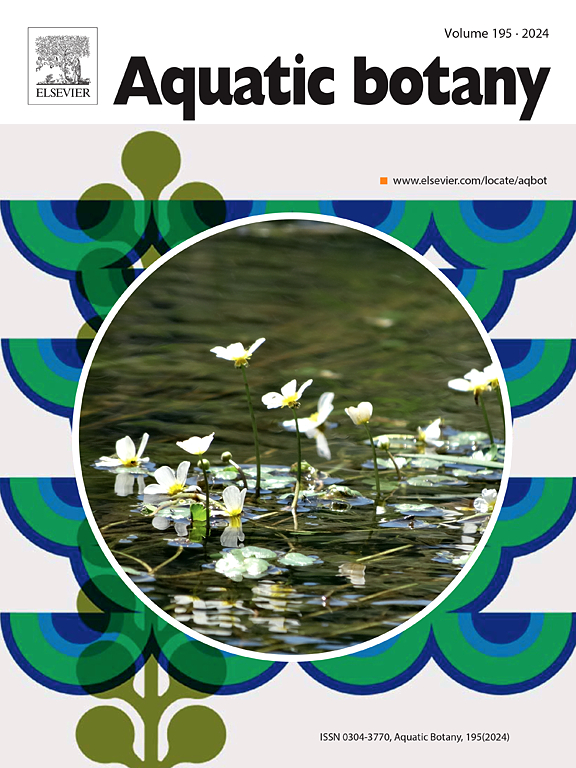Phytohormone profiles in leaves and traps of three Genlisea (Lentibulariaceae) species
IF 2.6
4区 生物学
Q2 MARINE & FRESHWATER BIOLOGY
引用次数: 0
Abstract
Genlisea (Lentibulariaceae) is a tropical genus of rootless wetland carnivorous plants. The belowground leaf (rhizophyll) is a Y-shaped organ which functions as an ‘eel trap‘ for soil microorganisms. We compared phytohormonal profiles (cytokinins, auxins, ABA) in green photosynthetic leaves, upper trap segments (including the vesicle for prey digestion) and lower branched trap segments functioning as trap entrances, in three Genlisea species from a pot culture. Relatively low contents of total cytokinins (35–1017 nmol kg−1; dry weight) and active cytokinins (7–213 nmol kg−1) occurred in the species. Those in upper trap segments, which fulfill demanding physiological functions, usually exceeded several times those in branched trap segments or green leaves. Generally, auxin contents were enormously variable across the species. Auxin contents (both IAA and total contents) in both organ types in G. hispidula and G. uncinata exceeded those in the G. lobata × flexuosa hybrid by one–three orders of magnitude. The highest free IAA content was usually in green leaves followed by upper and branched trap segments. However, the ABA content, as a hormonal criterion for plant dormancy, was consistently very low in all organs and species, indicating no growth limitation by this inhibitory hormone. The comparison of these hormone profiles with those from the literature in the phylogenetically related sister genus Utricularia (six aquatic species) has indicated that the very low cytokinin contents in Genlisea organs could reflect their very low growth rate as compared to rapidly growing aquatic Utricularia species.
三种genlisae (Lentibulariaceae)植物叶片和诱捕器的植物激素谱
龙舌兰属(扁桃科)是热带无根湿地食肉植物属。地下叶(根茎叶)是一个y形器官,其功能是“鳗鱼陷阱”的土壤微生物。我们比较了三种草属植物盆栽的绿色光合叶片、上部陷阱段(包括用于猎物消化的囊泡)和下部分支陷阱段作为陷阱入口的植物激素谱(细胞分裂素、生长素、ABA)。总细胞分裂素含量相对较低(35-1017 nmol kg−1);干重)和活性细胞分裂素(7-213 nmol kg−1)均出现在该物种中。上陷阱段的生理功能要求高,通常超过分枝陷阱段或绿叶的数倍。总的来说,不同物种的生长素含量差异很大。两种器官类型的生长素含量(IAA和总含量)均比大叶草和 弯曲草杂交品种高1 - 3个数量级。游离IAA含量最高的通常是叶片,其次是叶片上部和分枝节。然而,作为植物休眠激素标准的ABA含量在所有器官和物种中一直很低,表明这种抑制激素不受生长限制。将这些激素谱与系统发育相关的姐妹属水蛭属(6种水生物种)的文献比较表明,与快速生长的水生水蛭属相比,水蛭属器官中细胞分裂素含量非常低,这可能反映了它们的生长速度非常低。
本文章由计算机程序翻译,如有差异,请以英文原文为准。
求助全文
约1分钟内获得全文
求助全文
来源期刊

Aquatic Botany
生物-海洋与淡水生物学
CiteScore
3.80
自引率
5.60%
发文量
70
审稿时长
6 months
期刊介绍:
Aquatic Botany offers a platform for papers relevant to a broad international readership on fundamental and applied aspects of marine and freshwater macroscopic plants in a context of ecology or environmental biology. This includes molecular, biochemical and physiological aspects of macroscopic aquatic plants as well as the classification, structure, function, dynamics and ecological interactions in plant-dominated aquatic communities and ecosystems. It is an outlet for papers dealing with research on the consequences of disturbance and stressors (e.g. environmental fluctuations and climate change, pollution, grazing and pathogens), use and management of aquatic plants (plant production and decomposition, commercial harvest, plant control) and the conservation of aquatic plant communities (breeding, transplantation and restoration). Specialized publications on certain rare taxa or papers on aquatic macroscopic plants from under-represented regions in the world can also find their place, subject to editor evaluation. Studies on fungi or microalgae will remain outside the scope of Aquatic Botany.
 求助内容:
求助内容: 应助结果提醒方式:
应助结果提醒方式:


